Building a New Nation
1600s New England and Middle colonies settled by mix of free farmers and craftsmen, many indentured servants, and some African slaves; Skilled workers form first guilds
1607 English planters found Jamestown colony and complain about lack of laborers
1619 Slaves from Africa first imported to colonies
1660 Virginia passes slave codes making slavery perpetual and setting punishments for misbehavior
1664 First slavery codes begin trend of making African servants slaves for life
1676 Bacon’s Rebellion pits poor Virginia farmers, indentured servants and African slaves against wealthy English planters and Indians in a struggle over land; Leads to the substitution of slaves for indentured servants in the plantation economy
1677 First recorded prosecution against strikers in New York City
1765 Artisans and laborers in Sons of Liberty protest oppressive British taxes
1770 British troops kill five dock workers in Boston Massacre
1773 Boston Tea Party – working people with a few wealthy patriots dump a shipload of tea in Boston Harbor to protest British taxes and royal monopolies
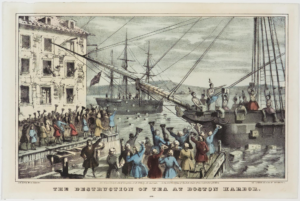
1775 American Revolution begins
1786 Philadelphia printers conduct first successful strike for increased wages
1787 Constitution adopted
1791 First strike in building trades by Philadelphia carpenters for a 10-hour day bill of Rights adopted
Struggles for Freedom
1800 Gabriel Prosser’s slave insurrection in Virginia
1805 Philadelphia shoemakers found guilty of conspiracy
1808 Slave importation prohibited
1834 First turnout of “mill girls” in Lowell, Mass., to protect wage cuts
1835 General strike for 10-hour day in Philadelphia
1842 Commonwealth v. Hunt decision frees unions from some prosecutions
1843 Lowell Female Labor Reform Association begins public petitioning for 10-hour day
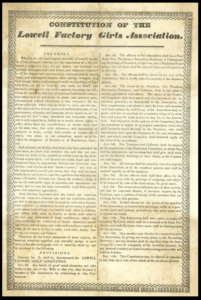
1847 New Hampshire enacts first state 10-hour-day law
1848 Seneca Falls women’s rights convention
1860 Great shoemaker’s strike in New England
1861 Abraham Lincoln takes office as president and Civil War begins
1863 President Lincoln issues Emancipation Proclamation
1865 13th Amendment to the Constitution abolishes slavery
Origins of Today’s Union Movement
1866 National Labor Union founded
1867 Congress begins reconstruction policy in former slave states
1869 Noble and Holy Order of the Knights of Labor and Colored National Labor Union formed
1870 15th Amendment to the Constitution adopted; states the right to vote may not be abrogated by color
1877 National uprising of railroad workers Ten Irish coal miners (“Molly Maguires”) hanged in Pennsylvania; nine more subsequently were hanged
1881 Federation of Organized Trades and Labor Unions formed
1881 First Labor Day parade in New York City
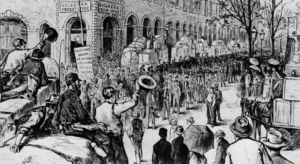
1885 Knights of Labor on the Southwest (or Gould) System: the Missouri Pacific; the Missouri, Kansas and Texas; and the Wabash
1886 American Federation of Labor founded
1887 Seven “anarchists” charged with the bombing in Chicago’s Haymarket Square and sentenced to death
1890 Carpenters President P.J. McGuire and the union strike and win the eight-hour day for some 28,000 members
1892 Iron and steel workers union defeated in lockout at Homestead, Pa.
1892 Integrated general strike in New Orleans succeeds
1894 Boycott of Pullman sleeping cars leads to general strike on railroads
1898 Erdman Act prohibits discrimination against railroad workers because of union membership and provides for mediation of railway labor disputes
The Progressive Era
1900 AFL and National Civic Federation promote trade agreements with employers
1900 U.S. Industrial Commission declares trade unions good for democracy.
1902 Anthracite strike arbitrated after President Theodore Roosevelt intervenes
1903 Women’s Trade Union League formed at AFL convention
1905 Industrial Workers of the World founded
1909 “Uprising of the 20,000” female shirtwaist makers in New York strike against sweatshop conditions
1909 Unorganized immigrant steel workers strike in McKees Rocks, Pa. and win all demands
1911 Triangle Shirtwaist factory in fire in New York kills nearly 150 workers
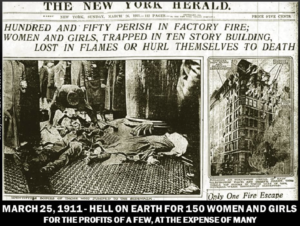
1912 Bread and Roses strike begun by immigrant women in Lawrence, Mass., ended with 23,000 men and women and children on strike and with as many as 20,000 on the picket line
1912 Bill creating Department of Labor passes at the end of congressional session
1913 Woodrow Wilson takes office as president and appoints the first secretary of labor, William B. Wilson of the Mine Workers
1914 Ludlow Massacre of 13 women and children and seven men in Colorado coal miners’ strike
1917 United States enters World War I
1918 Leadership of Industrial Workers of the World sentenced to federal prison on charges of disloyalty to the United States
1919 One of every five workers walked out in great strike wave, including national clothing coal and steel strikes; a general strike in Seattle; and a police strike in Boston
1919 International Labor Organization founded in France
Repression and Depression
1920 19th Amendment to the Constitution gives women the right to vote
1921 William Quesse led the merger of the Chicago Flat Janitor’s Union and six other small janitors unions to form the Building Service Employees International Union, which would later become SEIU
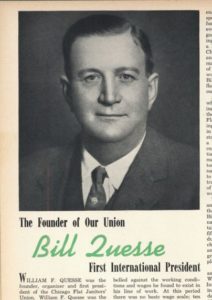
1924 Samuel Gompers dies; William Green becomes new AFL president
1925 A. Philip Randolph helps create the Brotherhood of Sleeping Car Porters
1926 Railway Labor Act sets up procedures to settle railway labor disputes and forbids discrimination against union members
1929 Stock market crashes as stocks fall 40 percent; Great Depression begins
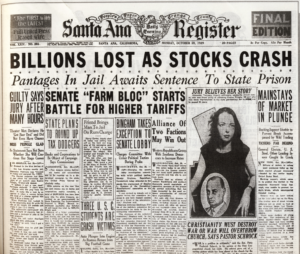
1931 Davis-Bacon Act provides for prevailing wages on publicly funded construction projects
1932 Norris-LaGuardia Act prohibits federal injunctions in most labor disputes
1933 President Franklin Roosevelt proposes New Deal programs to Congress
Democratizing America
1934 Upsurge in strikes, including national textile strike, which fails
1935 National Labor Relations Act and Social Security Act passed
1935 Committee for Industrial Organization (CIO) formed within AFL
1936 AFL and CIO create labor’s Non-Partisan League and help President Roosevelt win re-election to a second term
1937 Auto Workers win sit-down strike against General Motors in Flint, Mich.
1937 Brotherhood of Sleeping Car Porters wins contract with Pullman Co.
1938 Fair Labor Standards Act establishes first minimum wage and 40-hour week
1938 Congress of industrial Organizations forms as an independent federation
1940 John L. Lewis, who led a successful coal miner’s strike in 1919, resigns and Philip Murray becomes CIO president
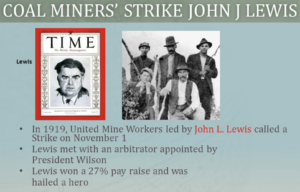
1941 A. Philip Randolph threatens march on Washington to protest racial discrimination in defense jobs
1941 U.S. troops enter combat in World War II
1941 National War Labor Board created with union members
1943 CIO forms first political action committee to get out the union vote for President Roosevelt
The Fight for Economic and Social Justice
1946 Largest strike wave in U.S. history
1947 Taft-Hartley Act restricts union members’ activities
1949 First two of 11 unions with Communist leaders are purged from CIO
1952 William Green and Philip Murray die; George Meany and Walter Reuther become presidents of AFL and CIO, respectively
1955 AFL and CIO merge; George Meany becomes president
1959 Labor Management Reporting and Disclosure Act (Landrum-Griffin) passed
1962 President John Kennedy’s order gives federal workers the right to bargain
1963 March on Washington for jobs and Justice
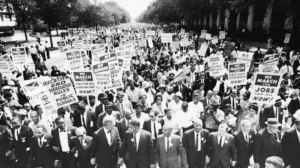
1963 Equal Pay Act bans wage discrimination based on gender
1964 Civil Rights Act bans institutional forms of racial discrimination
1965 AFL-CIO forms A. Philip Randolph Institute
1965 César Chávez forms AFL-CIO United Farm Workers Organizing Committee
1968 Dr. Martin Luther King Jr. assassinated in Memphis, Tenn., during sanitation workers’ strike
Progress and New Challenges
1970 Occupational Safety and Health Act passed
1972 Coalition of Black Trade Unionists formed
1973 Labor Council for Latin American Advancement founded
1974 Coalition of Labor Union Women founded
1979 Lane Kirkland elected president of AFL-CIO
1981 President Reagan breaks air traffic controllers’s strike and decertifies their union, PATCO; This unleashes over a decade of union busting
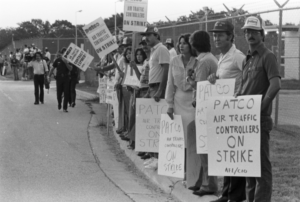
1981 Half a million trade unionists and supporters rally in Washington for Solidarity Day against Reagan’s economic policies; It’s the largest labor rally in history
1989 Organizing Institute created
1990 United Mine Workers of America win strike against Pittston Coal
1990 United Steelworkers of America labor Alliance created within the AFL-CIO
1990 The “Justice for Janitors” Campaign gets underway in Los Angeles 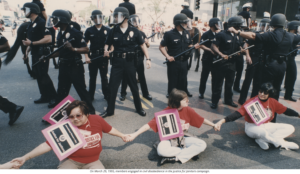
1997 AFL-CIO defeats legislation giving the president the ability to “Fast Track’ trade legislation without assured protection of workers’ rights and the environment
1997 Pride at Work, a national coalition of lesbian, gay bisexual and transgender workers and their supporters, becomes an AFL-CIO constituency group AFL-CIO membership renewed growth
1999 More than 75,000 human service workers are unionized in Los Angeles County
1999 30,000 to 50,000 working family activists take to Seattle streets to tell the World Trade Organization and its allies, “If the Global Economy Doesn’t Work for Working Families, It Doesn’t Work”
1999 5,000 North Carolina textile workers gain a union after a 25-year struggle
1999 65,000 Puerto Rico public-sector workers join unions
1999 Broad Campaign for Global Fairness pushes for economic and social justice worldwide
1999 Union movement organizes biggest program of grassroots electoral politics ever
2004 70,000 Southern California grocery workers strike Safeway to protect their health benefits and stop imposition of a vicious two-tier wage system
2005 Seven major national unions, including SEIU, representing six million workers, disaffiliate from the AFL-CIO and, in September and form a new labor coalition called “Change to Win”
2009 President Barack Obama signs the Lilly Ledbetter Fair Pay Act, which restored the rights of working women to sue over pay discrimination
2010 Several SEIU locals around Southern California decide to merge and form SEIU 721, which now represents more than 95,000 members
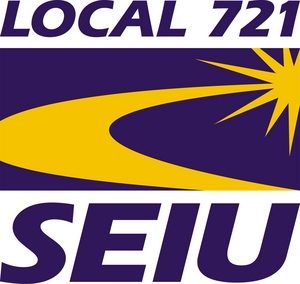 Sources:
Sources:
 Share
Share
 Share
Share
